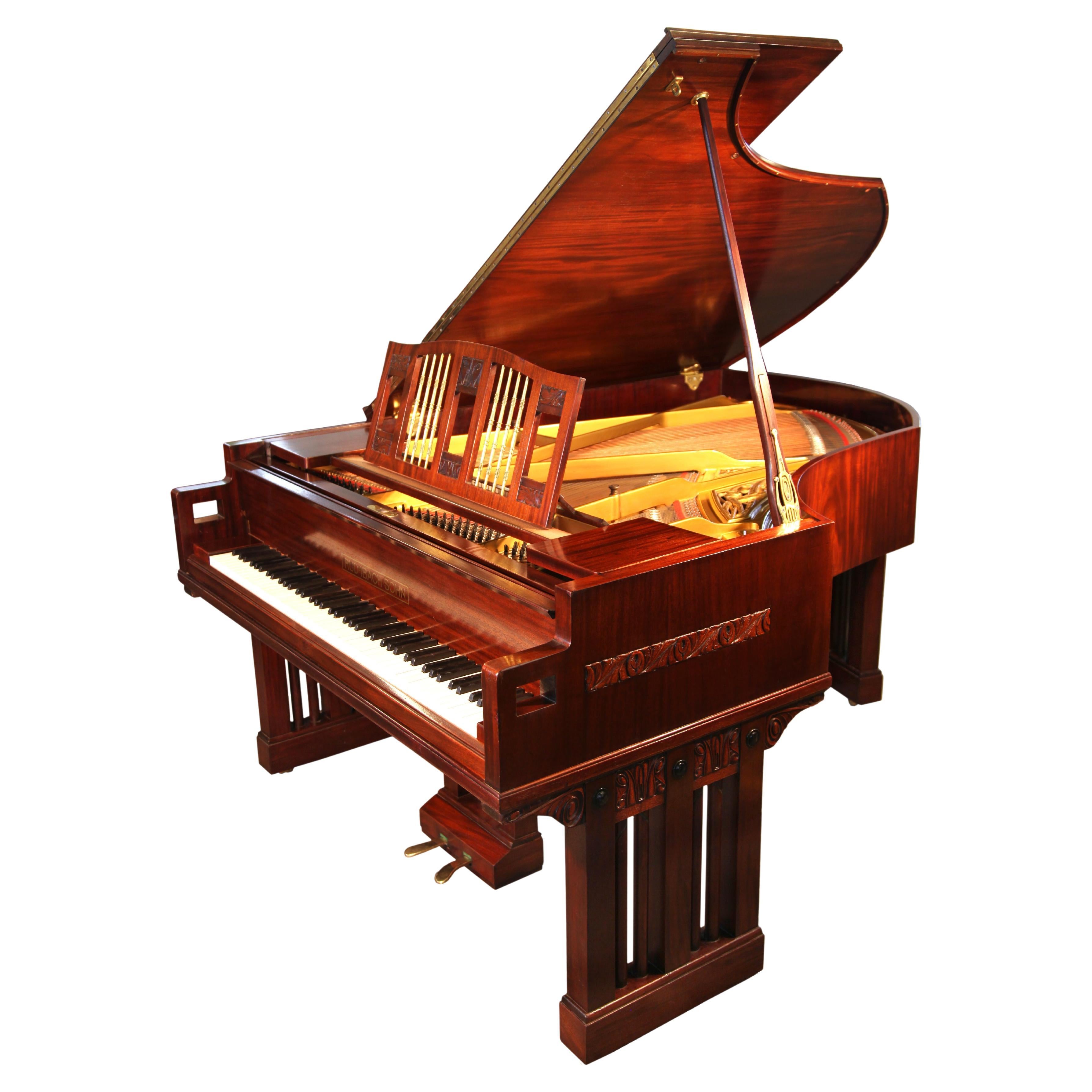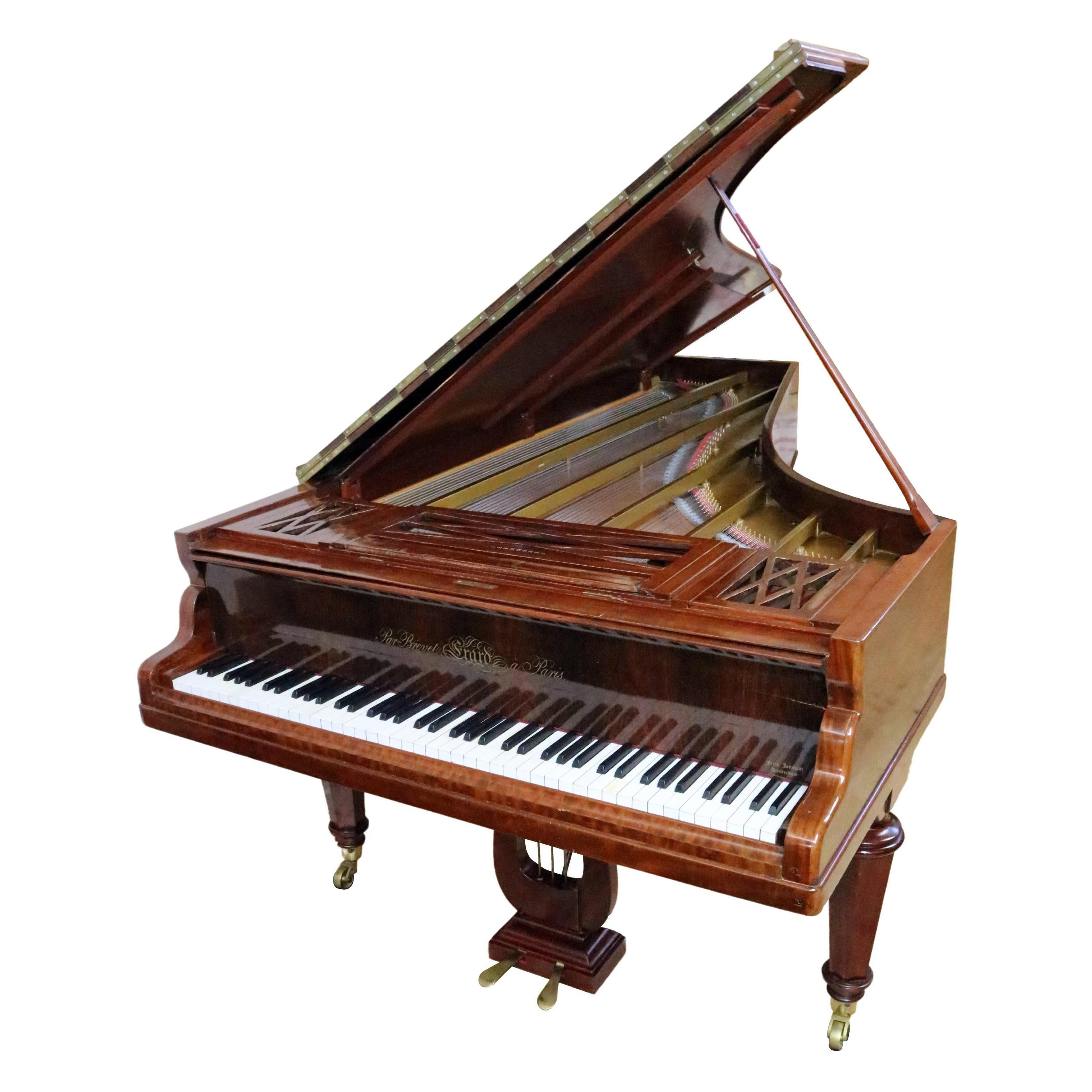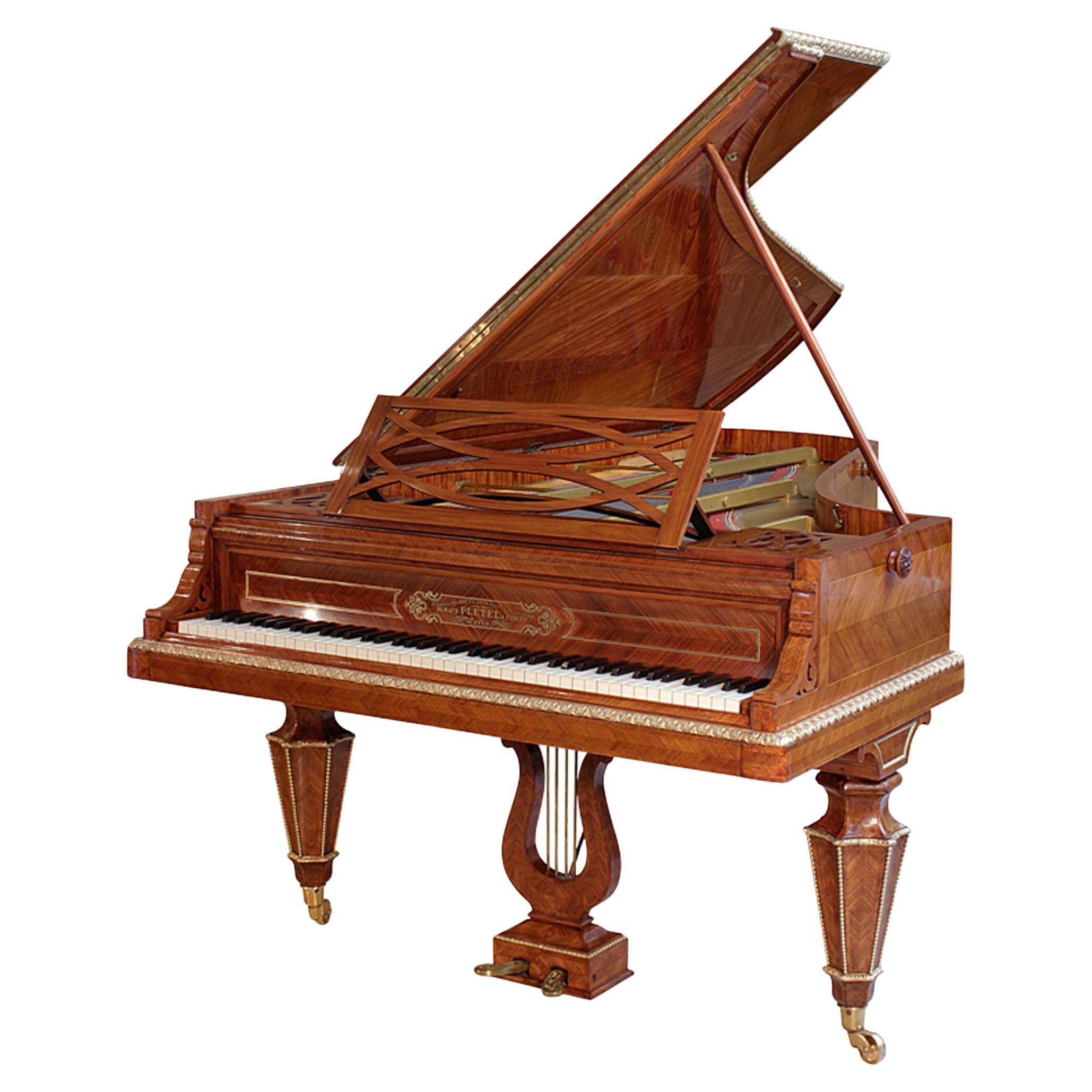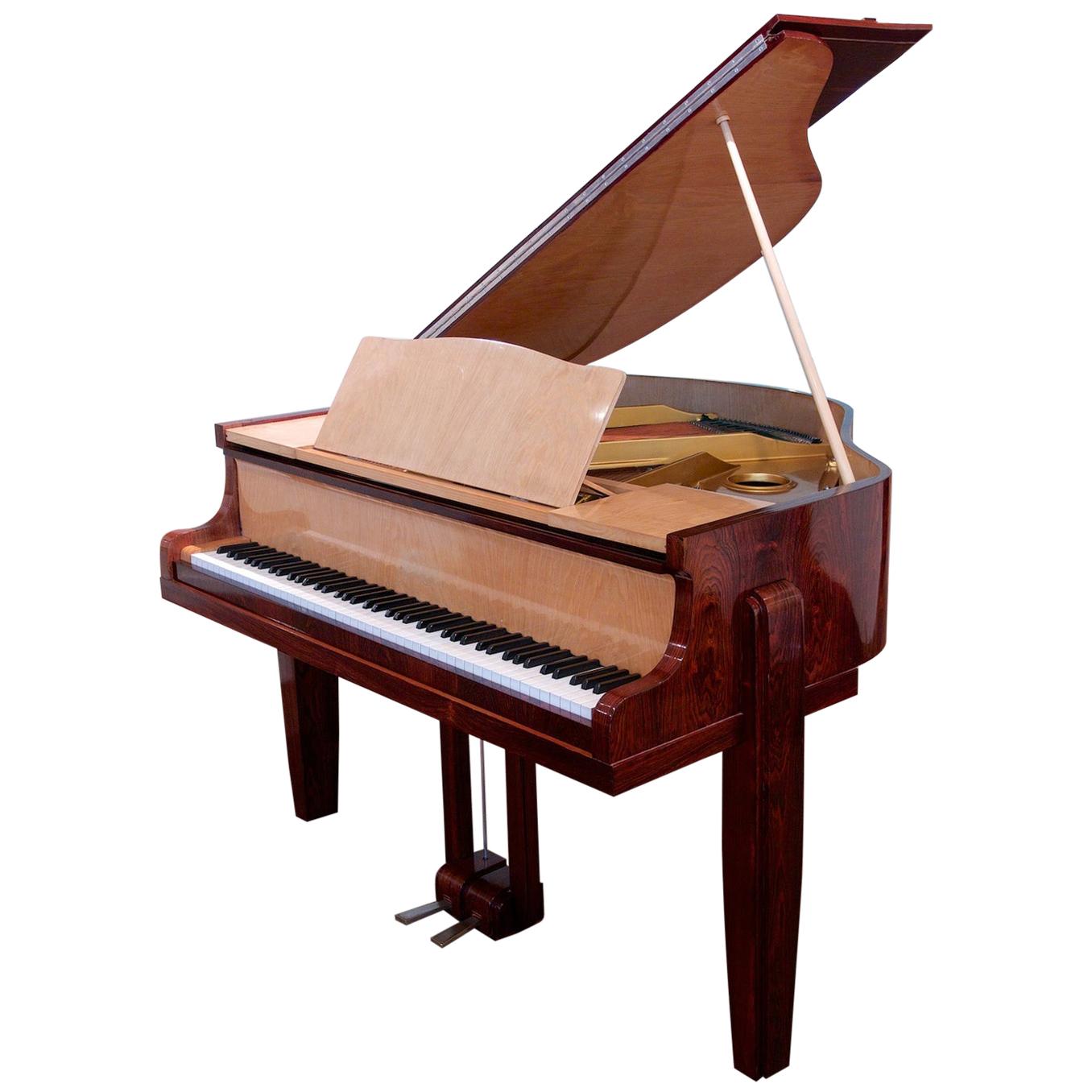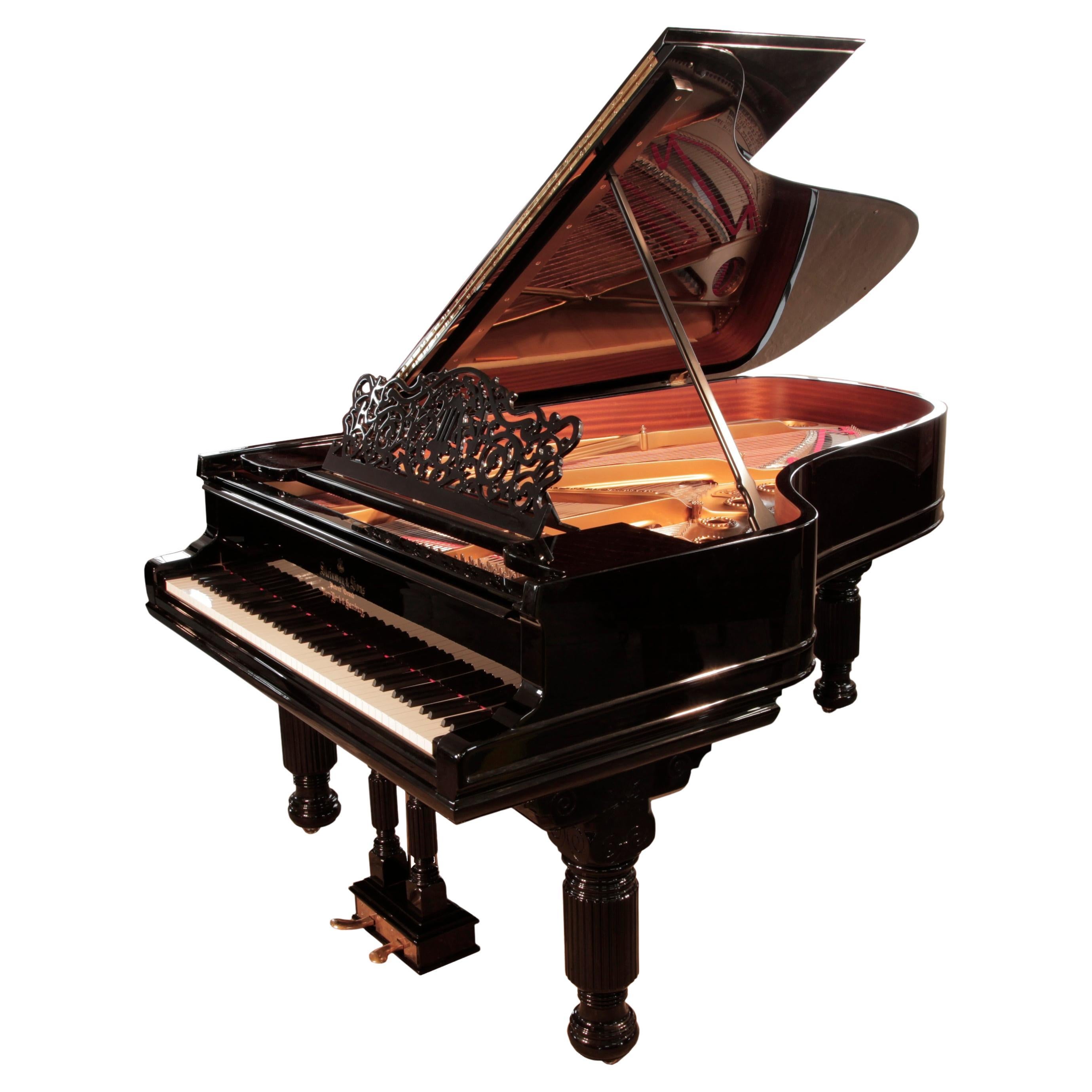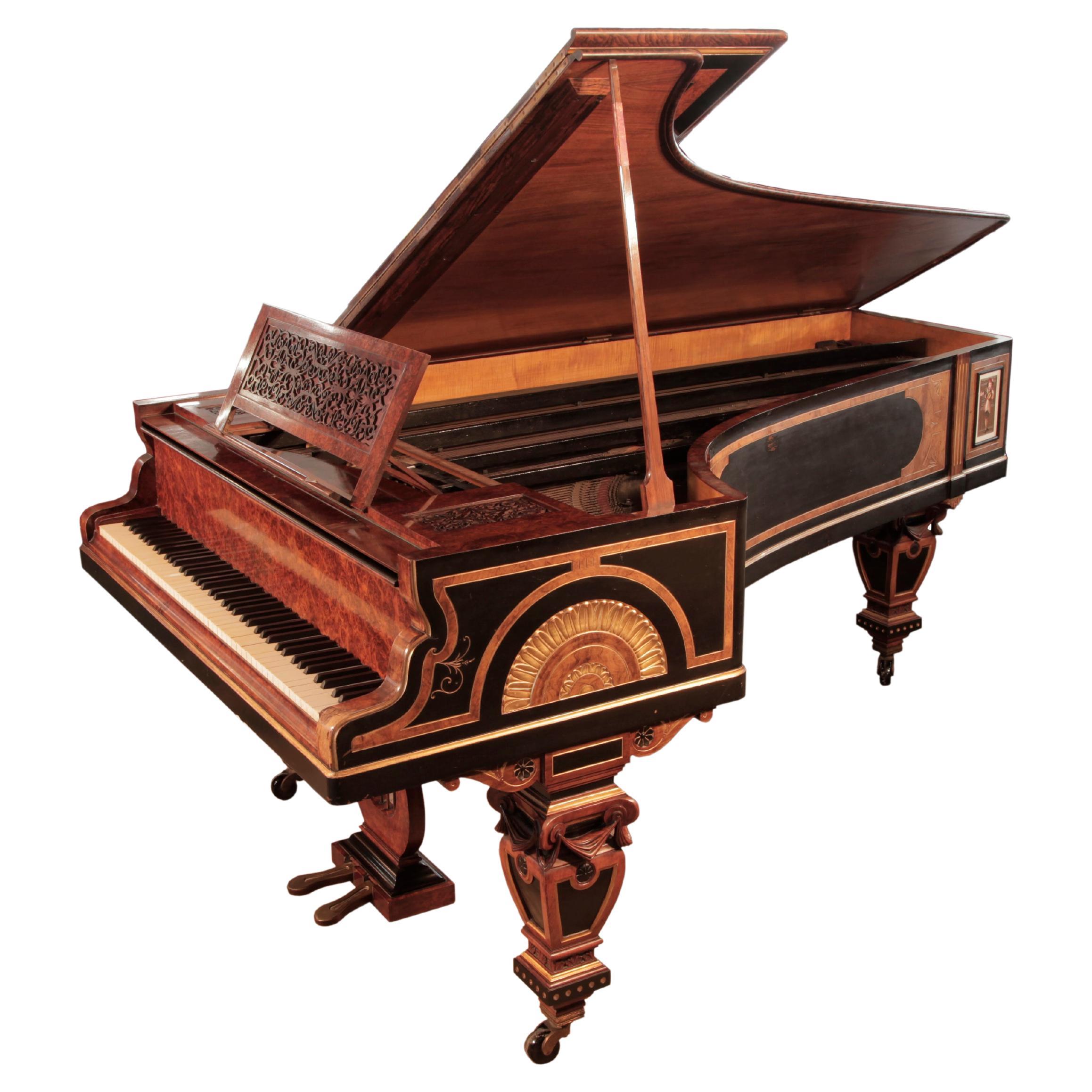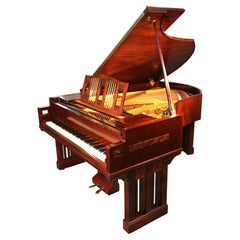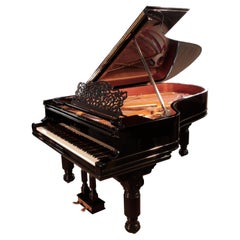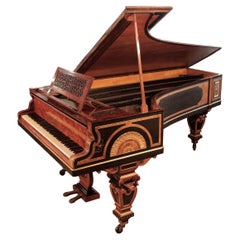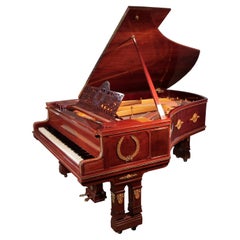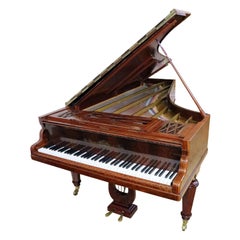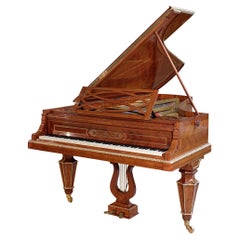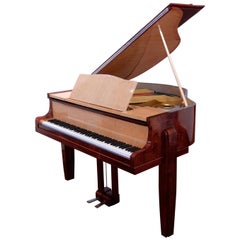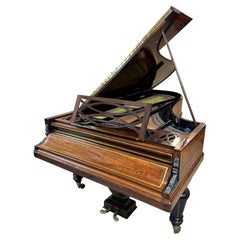Items Similar to Richard Strauss Ibach Cherry Gate Leg Grand Piano by Emanuel Von Seidl
Want more images or videos?
Request additional images or videos from the seller
1 of 13
Richard Strauss Ibach Cherry Gate Leg Grand Piano by Emanuel Von Seidl
$265,088.35
£194,500
€228,062.66
CA$365,712.44
A$406,687.41
CHF 213,601.03
MX$4,972,161.71
NOK 2,661,673.65
SEK 2,509,239.37
DKK 1,702,084.58
About the Item
Restored, 1907 Ibach Model 2 grand piano with a cherry case in a checkerboard design and inlaid, contrasting squares on the piano lid. Piano music desk is in an openwork dual criss-cross design. Piano has gate legs with four contrasting black spindles. Piano one of two designed for and offered to Richard Strauss by Ibach. Ibach made two pianos almost identical in this design except, the other #56279 had low, square piano cheeks. Richard Strauss chose that one as he intended the piano for his home where he hosted concerts and wanted his audience to be able to see his hands. This piano remained in the possession of Ibach and was used in exhibitions for promotional purposes. This piano was designed by Emanuel von Seidl, a German architect, interior designer and engineer. Between 1900 and 1918, Seidl was a successful villa architect and was known far beyond the borders of his hometown of Munich. Probably his most important private houses include that of Richard Strauss with its generously glazed bay window and view of the Alps, and the country estate Schloss Wolfsbrunn built for the mining entrepreneur Georg Wolf.
- Dimensions:Height: 42.92 in (109 cm)Width: 59.06 in (150 cm)Depth: 78.75 in (200 cm)
- Materials and Techniques:
- Place of Origin:
- Period:1900-1909
- Date of Manufacture:1907
- Condition:Repaired: Piano has been sympathetically restored in Germany by Steinway Academy trained technicians. Action original with re-felted hammers. Wear consistent with age and use. The cabinet shows some signs of wear and tear with some dents and scratches. Some scratches have been sympathetically touched up to disguise the marks.
- Seller Location:Leeds, GB
- Reference Number:Seller: Ref 28141stDibs: LU6879229002892
About the Seller
No Reviews Yet
Vetted Professional Seller
Every seller passes strict standards for authenticity and reliability
Established in 1979
1stDibs seller since 2022
5 sales on 1stDibs
- ShippingRetrieving quote...Shipping from: Leeds, United Kingdom
- Return Policy
Authenticity Guarantee
In the unlikely event there’s an issue with an item’s authenticity, contact us within 1 year for a full refund. DetailsMoney-Back Guarantee
If your item is not as described, is damaged in transit, or does not arrive, contact us within 7 days for a full refund. Details24-Hour Cancellation
You have a 24-hour grace period in which to reconsider your purchase, with no questions asked.Vetted Professional Sellers
Our world-class sellers must adhere to strict standards for service and quality, maintaining the integrity of our listings.Price-Match Guarantee
If you find that a seller listed the same item for a lower price elsewhere, we’ll match it.Trusted Global Delivery
Our best-in-class carrier network provides specialized shipping options worldwide, including custom delivery.More From This Seller
View AllArts and Crafts Ibach Grand Piano Mahogany Designed by Dutch Architect Cuypers
Located in Leeds, GB
A 1916, German Arts and Crafts, Ibach grand piano with a mahogany case and carved panel detail. The mahogany cabinet is polished so as to emphas...
Category
Early 20th Century German Arts and Crafts Musical Instruments
Materials
Brass
Rebuilt Steinway Model B Grand Piano Arabesque Music Desk Fluted Barrel Legs
Located in Leeds, GB
Rebuilt, 1886, Steinway Model B grand piano with a black case.
The music desk is in an openwork arabesque design featuring a central lyre motif
surrounded by stylised tendrils and foliage. The serpentine piano cheek features a dual linear case moulding. The piano lyre has two fluted spindle upright supports with two brass pedals and a brass footplate. The fluted, barrel piano legs have sunken brass casters. The leg pediment is carved with a stylised flower and curlicues. Piano has an eighty-five note keyboard.
Enjoy the vintage styling of an antique Steinway...
Category
Antique Late 19th Century German Musical Instruments
Materials
Brass
Erard Grand Piano Egyptian Revival Neoclassical Style by William Lomax Walnut
Located in Leeds, GB
An 1861, Erard grand piano with an ornate burr walnut, black and gilt cabinet. Piano casework features Egyptian Revival and Neoclassical elements. Th...
Category
Antique Mid-19th Century English Neoclassical Musical Instruments
Materials
Porcelain, Walnut, Giltwood
Empire Style Ibach Model 2 Grand Piano Mahogany Case Ormolu Mounts
Located in Leeds, GB
Empire style, 1901, Ibach model 2 grand piano with a mahogany case and gate legs. Entire cabinet decorated with ormolu mounts depicting classical scenes of gods, goddesses and wreaths. This piano is one of 12 unique instruments made as exhibition models...
Category
Early 20th Century German Empire Musical Instruments
Materials
Mahogany
Adams Style Bluthner Grand Piano Quarter Cut Satinwood Inlaid Swags and Bows
Located in Leeds, GB
Adams style, 1911, Bluthner grand piano with a french polished, quarter cut, satinwood case with boxwood stringing inlay and crossbanding accents. The satinwood veneer of the cabinet...
Category
Early 20th Century German Adam Style Musical Instruments
Materials
Brass
Wilh Steinberg WS-D275 Concert Grand Piano Bespoke For York Minster
Located in Leeds, GB
Wilh Steinberg WS-D275 concert grand piano with a black case and brass fittings. Piano has tapered spade piano legs with dual casters for ease of movement that are fitted with brakes...
Category
2010s Chinese Musical Instruments
Materials
Brass
You May Also Like
Erard Parallel-Strung Grand Piano, Paris, 1845
By Sébastien Érard
Located in Littleton, CO
This Erard parallel-strung grand piano, crafted in Paris in 1845 (serial number: 18725), has been extraordinarily well-tended, restored and maintained, enduring today as not only a spectacular example of the pinnacle of 19th Century piano design - characterized by its innovative construction and exceptional sonoral qualities - but also as a premium instrument by the most advanced modern standards, concert-ready for world-class, discriminating performers and their audiences.
Erard was a renowned piano manufacturer established by Sébastien Erard, and for much of the 19th Century, the company produced some of the most exquisite and innovative European pianos of the era.
The sound produced by this parallel-strung grand piano is characterized by a clarity and transparency that distinguishes it from its contemporaries. The parallel arrangement of strings contributes to a more direct transfer of sound energy, resulting in a balanced and articulate tone across the instrument's registers.
This piano's tone is beloved for its sweetness in the treble range and a robust quality in the bass, while also allowing for an especially nuanced and expressive interpretation of the musical repertoire of its era.
The ebony and ivory keyboard is a testament to the meticulous attention Erard paid to the tactile experience of playing. Each key is precision-weighted, providing a responsive touch that allows the pianist to articulate a wide range of dynamics and expressiveness.
An interior faux tableau latches to the outer case lid in an open position for maximum concert volume, and rests in a lowered position to maintain a softer, more muted experience.
The year 1845 places this Erard instrument in the heart of the Romantic era, a period marked by a surge in musical creativity and emotional expression. Composer/performers like Chopin and Liszt were drawn to Erard grand...
Category
Antique Mid-19th Century French Romantic Musical Instruments
Materials
Wood
French Mid-19th Century Concert Grand Piano Signed Pleyel
By Pleyel
Located in West Palm Beach, FL
A spectacular French mid-19th century, circa 1855, Louis XVI st. tulipwood parquetry and ormolu mounted, Model 2 Concert Grand Piano, signed Pleyel...
Category
Antique 19th Century French Louis XVI Musical Instruments
Materials
Ormolu
Pierre-Paul Montagnac Modernist Piano
By Pierre-Paul Montagnac
Located in Philadelphia, PA
French Modernist Art Deco piano and bench by Pierre-Paul Montagnac, a variant of the model used in one of the luxe apartments, the Caen, on the great French oceanliner Normandie in 1935. Created in rosewood and sycamore, and carefully and correctly restored, including the fine Erard (#127208) instrument. 56” wide x 60” deep. Documented in numerous sources, including the July 1935 issue of Art et Decoration.
Pierre-Paul Montagnac
(1883-1961)
Born in Saint-Denis, France on 9 May 1883, Pierre-Paul Montagnac was equally talented as a fine artist and a decorative artist. He was educated in both disciplines, studying with Eugene Carriére as well as at the Académie de la Grande Chaumiére, both in Paris.
His inaugural exhibition was at the 1912 Salons – and at the 1920 Salon d’Automne he received a traveling scholarship. In 1918 he began working in the firm of André Mare and from 1922 collaborated with Maurice Dufrene at La Maîtrise, the famous design studio of Galeries Lafayette. From 1921 he exhibited at the Salons of la Société des Artistes Décorateurs, Salon des Architectes Modernes,
and internationally, in Barcelona and Leipzig. He designed suites on the grand French oceanliners, l’Atlantique, Normandie and Pasteur.
At the 1925 Paris International Exposition his work was in a standout class. At the 1937 Exhibition he organized the pavillion of the Artistes Decorateurs and personally won a Grand Prix. For the New York Exhibition in 1938, he was a member of the international jury, organized the group of Decorators, and, as architect, organized the exhibitions of jewelry and perfumes.
He became a member of the Society of Modern Architects and executed important and numerous architecture and decorating projects including the luxury apartments on the great French oceanliners l’Atlantique, Pasteur, and Normandie.
Vice President and then President of the Societe des Artistes Decorateurs from 1930-1938, he was also President of the Salon d’Automne and Vice President of the Committee of the Exhibition of Arts and Embellishments of Life; member of the steering committee of C.T.I. and Artistic Property, member of the Board of Directors of the Central Union of Decorative Arts. He was also an Officer of the Legion of Honor and received the Cross of War.
MONTAGNAC was the son of an engineer and he had a taste for geometry
and science that predisposed him to the rigors of architectural laws.
Multi-talented, he worked independently as a painter – who had
paintings acquired by the French government – while also working in
the related fields of architecture and decoration. His work included
homes, apartments, galleries, luxury shops, banks and the aforesaid
oceanliners.
As a designer/decorater, Montagnac had the taste for quality, luxurious
furniture, using precious woods, bronze extensions, ivory inlays, mother-of-pearl,
metal and coral. He advocated for a resolutely modern style and, free of all
pastiches, focused on beautiful cabinetry, the challenges of furniture design,
particularly from 1940 to 1945, captured all his attention.
The tireless activity of Montagnac, whose varied works are represented in
official museums and residences, was also recognized from a professional
and social point of view. He was a remarkable organizer, devoted to the
cause of art, to the defense of the trade and his colleagues. It was Montagnac
who, in 1939, with Anatole de Monzie, took the initiative to found the
ENTRAIDE to Artists (which provides support to talented young French artists).
MOBILIER ET DECORATION, September/October 1953
ERARD
An illustrious piano manufacturer, Sebastien Erard began building superior harpsichords in Paris in the mid-1700s, produced pianos for the French Court, and received a multitude of patents, many of which are still in use in piano manufacturing. Erard pianos were marketed as the finest pianos in the world and were owned by Queen Victoria, Franz Liszt, Chopin, Verdi, Ravel, and Felix Mendelssohn among many others. They continued to enjoy international success well into the 20th century. They were known for their unique sound quality, similar to the American square grand piano...
Category
Vintage 1930s French Art Deco Musical Instruments
Materials
Rosewood, Sycamore
Pleyel Grand Piano, Paris 1870
By Pleyel
Located in Littleton, CO
This Pleyel concert grand piano crafted in Paris in 1870 is a timeless masterpiece that embodies the elegance and craftsmanship of 19th-century French piano manufacturing. Pleyel instruments are renowned for their exceptional quality and rich musicality, representing the pinnacle of piano design in the Romantic era, and this piano – an early example of the technological innovation of cross-stringing that was burgeoning during the period – is one in a series of only six ever produced.
This piano is in extraordinarily immaculate condition with nearly every original part, including the soundboard, pristine ivory keys, and the brass inlay in its beautifully figured walnut cabinet. Candle stands slide forward on either side of the collapsable music desk.
This piano was first purchased by the French Count Charles Étienne Gustave Le Clerc, count of Juigné (1825-1900), one of the wealthiest landowners in Brittany and a member of the French National Assembly, later a member of the House of Representatives, and in late life, the Senate.
The piano was restored in 1997 at Maison Erard by master restorationist Frits Janmaat in Amsterdam, and later conditioned by Edwin Beunk.
In recent years, some of Europe's finest historically-informed musical artists played this Pleyel in PBS concert performances in collaboration with the late Sergiu Luca.
Standing on substantial carved legs and brass wheels, the piano exudes a majestic presence through the graceful lines of its Second Empire style cabinet that embodies the period's aesthetics.
The keyboard, meticulously crafted from ivory and ebony, is a testament to the attention to detail in every aspect. Its 85 keys...
Category
Antique 17th Century French Romantic Musical Instruments
Materials
Walnut
$125,000
Erard Parallel-Strung Grand Piano with Bench, Paris, 1895
By Sébastien Érard, Maison Erard
Located in Littleton, CO
This beautiful grand piano was built by Erard in Paris in 1895.
With irreplaceable original cabinet art created and signed by an artist named Finel - specifically commissioned by th...
Category
Antique 1890s French Romantic Musical Instruments
Materials
Metal
Antique Steinway & Sons Gold Bronze & Satinwood Baby Piano Circa 1910
Located in New Orleans, LA
This piano was made in the Hamburg Steinway & Sons factory and decorated in France. It is a beautiful instrument. As with most pianos, special shipping will be needed.
Category
Early 20th Century German Musical Instruments
Materials
Ormolu
